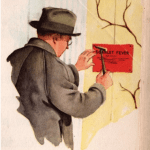Spanish Flu. SARS, MERS. Bubonic plague, if one wants to reach for a more distant point of reference. Such comparisons alarm us, or perhaps reassure us that things could be so much worse.
They were worse in New England in the seventeenth century. This year, communities on both sides of the Atlantic are marking the 400th anniversary of the Mayflower and the planting of Plymouth Colony. In light of the Covid-19 pandemic, it is worth remembering that the success of the Pilgrims rested more on biology than on Bibles. It is a dark and disturbing history.
Simply because of annual Thanksgiving elementary-school lessons, most Americans are aware that the Pilgrims suffered terribly during their first winter. They reached Cape Cod when it was already winter, and half of the Mayflower passengers perished from scurvy, malnutrition, and other ailments during the early months at Plymouth. According to William Bradford, the colony’s longtime governor, the few healthy risked their own lives to feed the sick and to wash “their loathsome clothes.” The Pilgrims earned their reputation for faithful perseverance and Christian charity, but these days were so horrifying that Bradford and his fellow colonists wrote very little about them.
By this time 399 years ago, though, the season of death was abating. The Pilgrims caught and shot enough fowl and fish to feed themselves, and they enjoyed a good harvest that summer and fall. When the Wampanoags heard the Pilgrims firing their guns, they came to see what was transpiring and ended up staying for several days of feasting and recreation. As far as most Americans are concerned, that’s the end of the Pilgrim story. A grim beginning, but a happy ending.
In reality, disease and death played a longer and more central role in the story of Plymouth and the other New England colonies. As soon as they started tromping around Cape Cod, the Pilgrims discovered fresh graves and abandoned homes. After they established their settlement, they learned why. Plymouth had been Patuxet, a densely populated Wampanoag community. Several years before the Mayflower, there had been an epidemic. Nearly everyone at Patuxet had died, and the few survivors had fled. In other communities, thousands of Wampanoags had perished. “They not being able to bury one another,” Bradford wrote, “their skulls and bones were found in many places lying still above the ground.” New England was a “new found Golgotha,” as a later colonist put it.
Historians disagree on the precise malady, which might have been smallpox, typhoid, or leptospirosis. Regardless, Europeans had brought the germs that had led to this wipe out. The Wampanoags had lived through something akin to the Black Death.
Without the epidemic, the Pilgrims probably would have had to settle somewhere else. In 1614, Thomas Hunt, an English ship captain, had kidnapped around twenty Wampanoags (including Tisquantum, or Squanto, who became one of the few Patuxet survivors of the epidemic). The Wampanoags might well have attacked the Pilgrims had it not been for their weakness and fear in the contagion’s wake. They did not welcome the newcomers, who they probably suspected were enslavers or bringers of disease. Some Wampanoags wanted to attack the Pilgrims, but others saw a political and military opportunity. Not all of the Native peoples of the region had been afflicted by the epidemic, and the Wampanoag sachem Ousamequin – whom the Pilgrims called Massasoit – sized up the ragtag Pilgrims as badly needed allies.
Some of the Pilgrims sympathized with the Wampanoags who had lost so many kin and admired their resilience. Mayflower passenger Edward Winslow commented on the “valor and courage” of two men, the survivors in their community.
For the most part, however, the English simply understood the epidemic as God’s gift to themselves. “By God’s visitation,” declared King James, “reigned a wonderful plague.” The Pilgrims knew that disease had cleared the way for their settlements. “There is none to hinder our possession,” wrote Winslow, “or to lay claim unto it.” The land was empty, and they could take it. “God hath a purpose to give that land as an inheritance to our nation.” God had punished heathen Indians with death in order to reward faithful Christians.
On at least some occasions, the Pilgrims used the threat of contagion to terrorize the Wampanoags. Hobomok, a Wampanoag who lived at Plymouth, asked the Pilgrims if they controlled the “plague.” No, they replied. “But the God of the English had it in store,” they told him, “and could send it at his pleasure.” The deaths of so many Indians were heaven sent.
Over the next century, outbreaks of smallpox and other diseases swept through Plymouth Colony and Massachusetts Bay, but none of these epidemics posed an existential threat to English societies. For Wampanoag and other Native peoples, however, the threat from European-brought diseases was a recurrent challenge. When English traders and settlers from Plymouth and Boston moved into the Connecticut River Valley in the 1630s, they brought smallpox with them. The Indians there died “like rotten sheep,” Bradford wrote. Their skin cleaved to the mats on which they lay and then flayed off their bodies when they turned. After English settlers arrived on Martha’s Vineyard in the 1640s, about half of the island’s Native population died over the next few years. Because the diseases killed Natives and largely spared English settlers, they discredited Native leaders and enhanced the stature of English missionaries.
European-brought epidemics, moreover, did not just affect “virgin” populations on a single occasion. Rather, well into the eighteenth century, recurrent epidemics such as small pox afflicted Native peoples again and again. The cycles of disease and death facilitated the ongoing conquest and displacement of Native populations, and English settlers took advantage through wars and land grabs. The English attributed their ongoing success to God’s blessing, but also to their own virtues and to what they understood as Native vice and sloth. They largely forgot that their most significant allies were invisible microbes.
Certainly elements of seventeenth-century New England are inspiring. Even if they did so out of wary political calculation rather than pure hospitality and goodwill, the Wampanoags enabled the survival of the fledgling Pilgrim settlement. Pilgrim Edward Winslow, for his part, once nursed a near-death Ousamequin back to health, going so far as to scrape pus out of his mouth and spoon feed him. In the end, though, the Pilgrim story contains plenty of sobering material, including the reminder that epidemics and other disasters create opportunities for greed and profit as well as charity.













